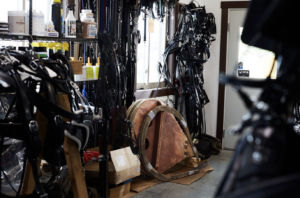Photographer / Jessica Whitehead
Carl Miller worked in a harness shop in Shipshewana for more than 20 years before deciding to launch his own business in 2018.
 The Newburyport Harness Shop offers leather goods, including harnesses, dog collars, belts, billfolds and more.
The Newburyport Harness Shop offers leather goods, including harnesses, dog collars, belts, billfolds and more.
He also creates show harnesses, similar to what you’d find on the Budweiser Clydesdales.
“The harnesses for show have to be very precise. You make an error and you have to start over. It’s got to be right because every little mistake shows up,” Miller said.
That’s not to say he’s not working toward perfection on all the projects he creates.
“I’m kind of a perfectionist. No one wants a job half done, so I take a lot of pride in a satisfied customer. I want them to be happy with the finished product,” Miller said.
The process is interesting and starts at a tannery—one of only about 150 in the United States, down from 1,500 in the early 1970s.
Making leather from the skins of animals is one of the oldest examples of making a byproduct of the food industry, as they typically take skins from those bound for the slaughterhouse. The first step takes several weeks to several months.
The quality of the leather makes a big difference when Miller purchases his product.
“I buy a chrome-tanned leather. You can use it for several different things. Depending on how they tan it, it’s a lot stronger and thicker. If you go with the Western hides, it’s tougher because of the weather conditions out there,” Miller said.
In addition to cowhide and deerskin, Miller also works with synthetic material, a coated rubber nylon.
Those shopping at the Shipshewana market or buying a new leather item from a store may not know the difference between genuine leather and fake. However, the type of leather will make a difference in how long an item remains in good condition.
“There are all kinds of grades of leather. You can buy cheap, imported leather, but I stay away from those, and I stay away from water buffalo leather too,” Miller said. “I only use deerskin or cowhides, which is a good, strong leather for a harness.”
The treatment of the item can make a difference too.
 “It’s important to take care of them. Leather harnesses should be oiled once per year in order to condition it. If you don’t, it’ll dry out as the oil evaporates from the heat and cold and sweat,” Miller said.
“It’s important to take care of them. Leather harnesses should be oiled once per year in order to condition it. If you don’t, it’ll dry out as the oil evaporates from the heat and cold and sweat,” Miller said.
After cutting the leather into whatever widths necessary, the artistry begins.
“I like working with leather and building harnesses and repairing things. It takes five or six hours for a billfold, for instance. I cut it out and then sew it together with a sewing machine,” Miller said.
He’s got his son working with him on occasion, but typically it’s the solitary work and creativity Miller enjoys the most.
The ultimate goal is to provide the best quality to hardworking customers who need something that can withstand weather and the strong pull of a horse-drawn vehicle or the consistent work of a farmer in the field.
Miller enjoys working for himself, but he also enjoys working with the customer and providing the perfect thing.
“I always tell my customers, if it doesn’t fit right, bring it back. I want it to be right,” Miller said.
Newburyport Harness Shop is at 3910 N. 1000 West, Shipshewana.










